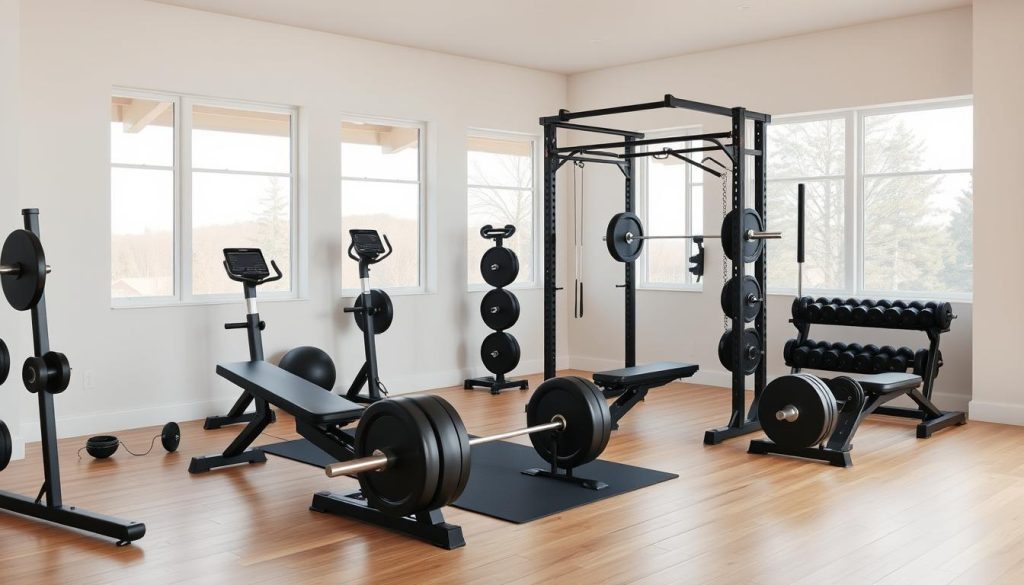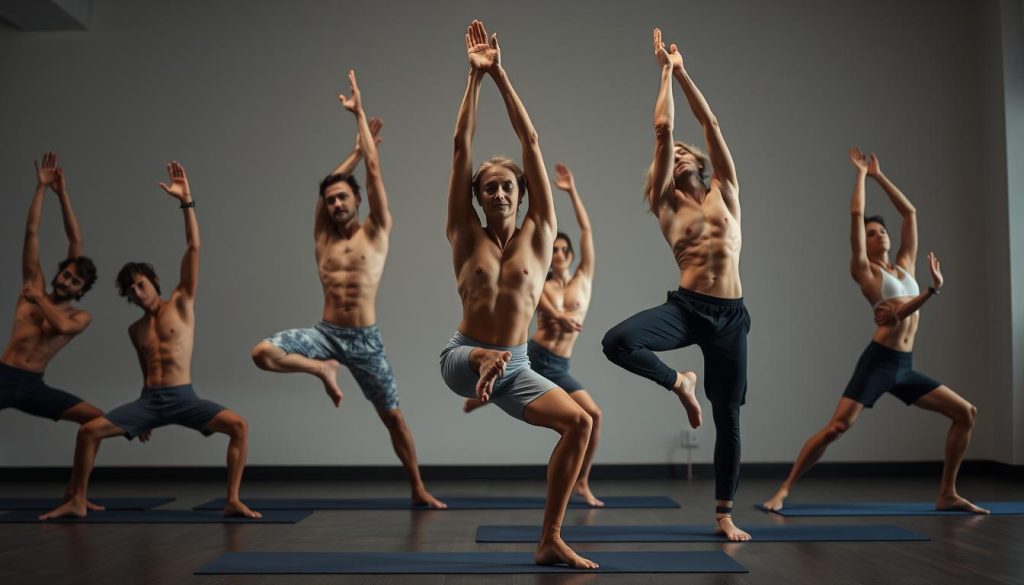I’m excited to share the ultimate fitness guide with you. Getting fit fast needs regular workouts, healthy eating, and enough rest. Interval training is a great start. It mixes high and low-intensity exercises, like running or swimming, in just 20 minutes.
Experts say walking is a great workout for everyone. Eating well is key, with lots of lean protein, fruits, veggies, and whole grains. Drinking eight 8oz glasses of water a day is also vital for top performance.
Fitness isn’t just about working out. It’s also about what you eat and how much rest you get. A good workout plan, healthy food, and enough sleep can help you reach your fitness goals and feel better overall.
Key Takeaways
- Interval training is an effective way to get fit fast, requiring only 20 minutes of alternating high and low-intensity exercises.
- Regular exercise, such as walking, is beneficial for all fitness levels and can be incorporated into your daily workout routine.
- A balanced diet with lean protein, fruits, vegetables, and whole grains is essential for optimal fitness performance.
- Staying hydrated by drinking eight 8oz glasses of water per day is crucial for fitness and overall health.
- A well-structured workout routine, combined with healthy nutrition and sufficient rest, can help you achieve your fitness goals and improve your overall well-being.
- Exercise, such as strength training and cardio, can help you burn fat and improve your overall fitness level.
- Getting enough rest and recovery time is essential for muscle growth and repair, and can help you avoid injury and burnout.
Understanding the Foundations of Fitness
To get fit and feel good, knowing the basics of fitness is key. A good fitness plan mixes cardio, strength training, and stretching. Activities like running, cycling, or swimming are great for cardio. Strength training can be done with weights or bodyweight exercises.
Setting goals that you can reach is important. It keeps you motivated and stops you from getting tired. Start with small goals, like exercising for 30 minutes, three times a week. You can always make your goals bigger as you get better.
Having a gym membership helps, but it’s not needed to start. Simple exercises like walking, stretching, or bodyweight exercises at home can get you going.
Being consistent is crucial for reaching your fitness goals. Find a routine that fits your life and stick to it. With hard work, the right attitude, and patience, you can improve your health and feel great. Regular exercise boosts your physical fitness, energy, and mental well-being.
Creating Your Perfect Workout Schedule
Getting fit is easier with a solid workout plan. As someone who loves personal training, I know a good plan keeps you motivated. It should mix cardio, strength training, and flexibility exercises.
Start by setting a regular time for workouts, like morning or after work. Don’t forget to include rest days, like Sundays, for your body to heal. Begin with 5 to 10 minutes of aerobic activity weekly and aim for 30 to 60 minutes daily.
Here are some tips for your workout schedule:
- Do at least 150 minutes of moderate aerobic activity weekly.
- Work out two times a week for major muscle groups.
- Do 12 to 15 reps for strength exercises.
- Don’t increase your activity level by more than 10% each week.
Listen to your body and adjust your plan as needed. Mix up your workouts to avoid boredom and injury. With a good plan and dedication to personal training, you can reach your physical fitness goals and live a healthy life.
https://www.youtube.com/watch?v=KYfenFzupL8&pp=ygURI2NvbXBvbmVudGZpdG5lc3M%3D
Stick to these tips and make a workout plan that fits your life. This way, you can reach your fitness goals.
| Workout Type | Frequency | Duration |
|---|---|---|
| Cardiovascular Exercise | 3-4 times a week | 30-60 minutes |
| Strength Training | 2-3 times a week | 30-45 minutes |
| Flexibility Exercises | 2-3 times a week | 10-15 minutes |
Essential Exercise Types for Maximum Results
To get the best results in fitness, mix different types of exercises. You need cardio, strength training, and work on flexibility and mobility. A balanced routine helps with losing weight and improves your nutrition.
Cardio, like running or cycling, boosts heart health and burns calories. Strength training, like lifting weights or doing bodyweight exercises, builds muscle and boosts metabolism. This helps with weight loss. Flexibility and mobility exercises, like yoga or Pilates, improve flexibility and lower injury risk. This makes it easier to keep up with your fitness and nutrition plans.
Cardiovascular Training Basics
Cardio is key to any fitness plan. It improves heart health, burns calories, and aids in weight loss. Here are some cardio exercises:
- Brisk walking
- Running
- Cycling
- Swimming
Strength Training Fundamentals
Strength training is vital for fitness. It builds muscle, boosts metabolism, and enhances nutrition. Here are some strength training exercises:
- Squats
- Lunges
- Push-ups
- Crunches
Flexibility and Mobility Work
Don’t forget about flexibility and mobility exercises. They improve flexibility and lower injury risk. Here are some examples:
- Yoga
- Pilates
- Stretching
| Exercise Type | Benefits |
|---|---|
| Cardiovascular Training | Improves cardiovascular health, burns calories, aids in weight loss |
| Strength Training | Builds muscle mass, increases metabolism, improves overall nutrition |
| Flexibility and Mobility Work | Improves flexibility, reduces risk of injury |
The Science Behind Physical Fitness
Exploring fitness reveals the amazing processes in our bodies during exercise. The science of physical fitness is complex and very interesting. It shows that regular exercise greatly improves our health and wellbeing. It helps prevent diseases like obesity, heart disease, and type 2 diabetes.
Research shows that different types of exercise can boost our fitness. For instance, a study on rats found that 8 weeks of endurance exercise training improved their aerobic capacity. This shows how important it is to exercise regularly to stay fit.

Also, studies have found that endurance exercise affects many genes linked to diseases. This knowledge helps create personalized exercise plans. By understanding the science of physical fitness, we can maximize the benefits of exercise. These benefits include better physical health and mental wellbeing.
Some key findings on the benefits of exercise and fitness include:
- Regular exercise can reduce the risk of chronic diseases
- Fitness levels can be improved through various forms of exercise
- Exercise can have a profound impact on mental wellbeing
Nutrition Strategies for Optimal Performance
Nutrition is key to reaching my health and wellness goals. A balanced diet gives my body the fuel it needs. This is true for both endurance activities and strength training. I make sure to eat a mix of complex carbs, lean protein, and healthy fats.
Before working out, I focus on carbs for energy. For example, I might eat brown rice, grilled chicken, and avocado. I also drink lots of water to stay hydrated.
Pre-workout Fuel Guidelines
Here are some tips for pre-workout nutrition:
- Eat a balanced meal 1-3 hours before exercising
- Include carbs, protein, and healthy fats
- Drink plenty of water
Post-workout Recovery Nutrition
After working out, I focus on refueling and muscle recovery. I eat a mix of carbs and protein within 30-60 minutes. Good snacks include a banana with peanut butter or a protein shake.
By focusing on nutrition, I improve my performance and quality of life. A balanced diet is crucial for my body’s needs, whether I’m doing endurance activities or strength training.
Building Your Home or Gym Workout Routine
Having a dedicated space for workouts can really help. A home gym can save you $30 to $100 each month on gym memberships. Plus, up to 60% of gym-goers feel awkward working out in public, preferring their own homes.
A simple home workout routine includes 6 key exercises: squats, deadlifts, bench press, rows, overhead press, and pull-ups. You can get the necessary equipment like an Olympic barbell and adjustable dumbbells for under $200. This makes setting up a home gym a budget-friendly option.
Working out at home has many benefits:
- Convenience: having a dedicated space saves time and boosts consistency
- Cost-effective: skipping gym fees can save a lot of money over time
- Comfort: exercising in a familiar place can make you feel less self-conscious

To reach your fitness goals, mix cardio, strength training, and flexibility exercises into your routine. With the right gear and a dedicated area, you can craft a workout plan that fits your lifestyle and preferences.
| Equipment | Cost | Benefits |
|---|---|---|
| Olympic barbell | $50-$100 | Essential for strength training exercises |
| Adjustable dumbbell | $20-$50 | Convenient and space-saving |
| Cardio equipment | $100-$500 | Improves cardiovascular health and burns calories |
Recovery and Rest: The Missing Link in Fitness
As I keep working on my fitness, I’ve learned how key recovery and rest are. It’s not just about personal training and pushing hard. My body needs time to fix and grow back. That’s where nutrition comes in, giving my body the fuel it needs.
A good recovery plan mixes rest, nutrition, and active recovery like foam rolling. This helps with muscle soreness, improves blood flow, and aids in fitness growth. By focusing on recovery, I avoid burnout and injuries, and keep moving towards my fitness goals.
- Getting at least 7-9 hours of sleep per night
- Incorporating active recovery techniques such as foam rolling or light cardio
- Eating a balanced diet that includes plenty of protein, healthy fats, and complex carbohydrates
- Staying hydrated by drinking plenty of water throughout the day
By adding these strategies to my fitness plan, I support my health and fitness goals. Whether I’m with a personal training coach or on my own, recovery and rest are key to success.
| Recovery Strategy | Benefits |
|---|---|
| Getting enough sleep | Improves physical recovery, supports muscle growth and repair |
| Incorporating active recovery techniques | Reduces muscle soreness, improves circulation, supports overall fitness progress |
| Eating a balanced diet | Supports muscle growth and repair, provides energy for workouts |
Tracking Progress and Staying Motivated
As I keep going on my fitness path, I’ve found that tracking my progress is key. Setting goals that feel achievable and keeping an eye on my workouts helps me stay motivated.
Studies show that those who track their actions, not just the outcomes, are 50% more likely to stick to their fitness plans. Mixing cardio and strength training in my routine lets me see my fitness grow.
To keep myself going, celebrating small wins and setting mini-goals really helps. Breaking down big goals into smaller ones makes it easier to see my progress. Plus, having someone to hold me accountable boosts my motivation and keeps me on track.
Some important ways to track progress and stay motivated include:
- Setting specific, measurable goals
- Tracking behaviors rather than results
- Celebrating small victories
- Having an accountability partner
By using these strategies, I’ve managed to stay motivated and track my progress. This has helped me reach my weight loss goals.
Common Fitness Mistakes to Avoid
Many people make mistakes in fitness that can slow down their progress and raise the risk of injury. To succeed in exercise and fitness, knowing these common mistakes is key. It’s important to avoid them.
Some common fitness mistakes include:
- Not warming up properly before a workout
- Not having a structured plan for workouts and nutrition
- Inadequate fueling before workouts
- Not stretching regularly
- Relying solely on cardio workouts
By avoiding these mistakes and following a well-structured fitness plan, you can improve your exercise routine. It’s also crucial to listen to your body and rest when needed. Overtraining can cause injury and burnout.
A successful fitness journey needs patience, dedication, and a willingness to learn and adapt. By avoiding common mistakes and sticking to your exercise routine, you can reach your goals. This will help you maintain a healthy, active lifestyle.
| Mistake | Consequence | Solution |
|---|---|---|
| Not warming up | Injury | Warm up for 10-15 minutes before each workout |
| Not having a plan | Lack of progress | Create a structured workout and nutrition plan |
| Inadequate fueling | Poor performance | Fuel your body with a balanced diet and stay hydrated |
Adapting Your Fitness Journey for Long-term Success
As I keep going on my fitness path, I’ve learned that being flexible is key. It’s about trying new things, listening to my body, and adjusting when needed. This helps me avoid hitting a wall and keeps me from getting hurt, which is bad for my health and wellness.
Tracking my progress is also vital. I watch my workouts, what I eat, and how much I rest. This helps me see where I can get better and make changes. It’s boosted my drive and dedication to my fitness goals. Studies show that logging your progress can make you 25% more likely to reach your fitness goals.
Some important tips for me have been:
- Setting goals that are real and reachable, using the SMART goals framework
- Mixing up my workouts with cardio, strength training, and stretching
- Resting when my body tells me to
- Getting support from friends, family, or a fitness group
By using these tips, I’ve seen big improvements and hit my goals. Remember, changing your fitness path is a journey. It’s okay to make mistakes and try new things. The main thing is to keep going, be patient, and focus on your health and wellness.
| Strategy | Benefits |
|---|---|
| Regular tracking and evaluation | 25% higher likelihood of achieving fitness goals |
| Setting realistic and achievable goals | 40% higher success rate in adhering to fitness plans |
| Incorporating a mix of exercise types | Improved overall fitness and reduced risk of injury |
Conclusion: Your Path to Lasting Fitness Success
As you finish your fitness journey, remember lasting success is more than short-term goals. It’s about building habits that last for your health and wellbeing. By setting realistic fitness goals, tracking your progress, and enjoying your workout routine, you unlock lasting success.
Studies show setting SMART fitness goals makes you 75% more likely to succeed. Tracking progress and trying different workouts keeps you motivated. With personal trainers and a gym like City Fitness, you can overcome challenges and reach your physical fitness goals.
Remember, fitness is a lifelong journey. Success comes from being consistent, dedicated, and adaptable. Embrace this mindset and take the right steps to make fitness a lasting part of your life. This will greatly improve your health and wellbeing.


